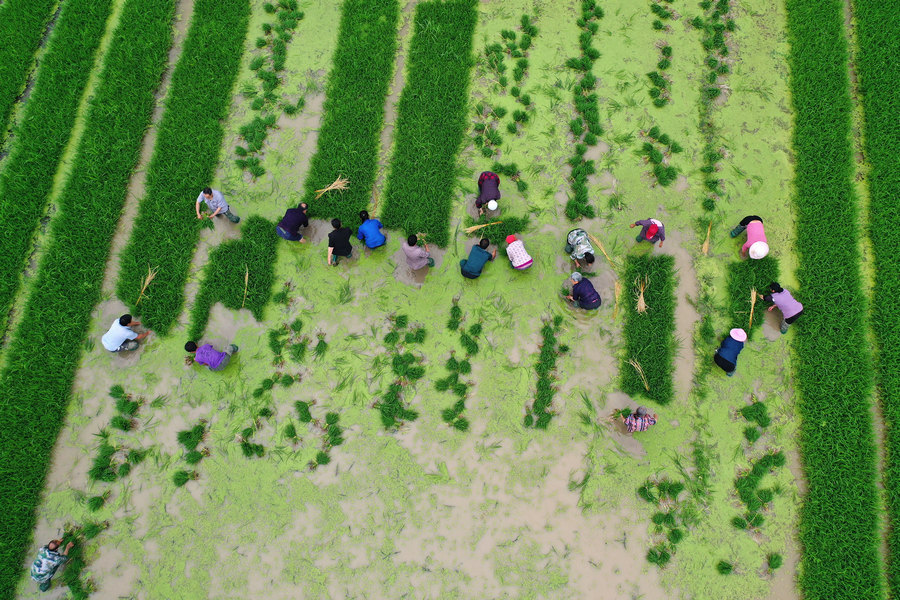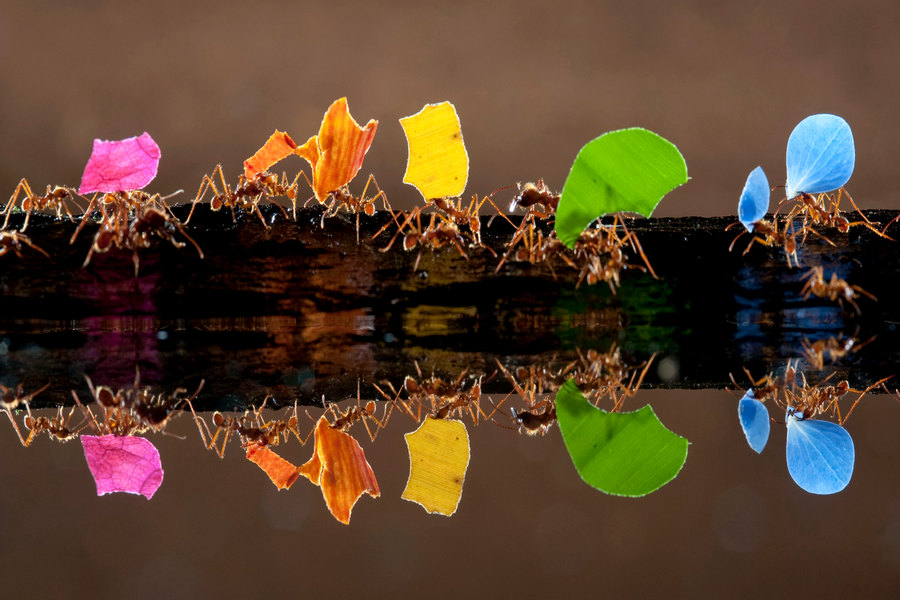A Big Moment for Biodiversity Conservation

Over the next few years, one million species could be pushed to extinction and bring serious consequences for human beings as well as the rest of life on Earth, warned the United Nations (UN) in 2019. Humans must act together to halt and reverse biodiversity loss and ecosystem degradation. This is why the upcoming 15th meeting of the Conference of the Parties to the Convention on Biological Diversity (COP15) has drawn so much attention.
Elizabeth Maruma Mrema, executive secretary of the Secretariat of the UN Convention on Biological Diversity (CBD), recently spoke with China Pictorial about preparations for COP15 and challenges and opportunities in biodiversity conservation. She called China’s notion of ecological civilization an excellent perspective on the relationship between humankind and nature and praised the country’s ecological restoration efforts over the past decades as a good model for future work in the international community.

Elizabeth Maruma Mrema, executive secretary of the Secretariat of the United Nations Convention on Biological Diversity (CBD). courtesy of the Secretariat of the CBD
China Pictorial: The COP15 biodiversity summit is scheduled to take place in October in Kunming, Yunnan Province, in southwestern China. What are your expectations for the summit?
Mrema: COP15 is a very significant meeting at which governments are expected to adopt the Post-2020 Global Biodiversity Framework, a 10-year strategy to engage the entire world in protecting nature and building a future of life in harmony with nature. Parties will seek agreement on increased mobilization of resources from all sources to fund biodiversity protection including redirecting negative biodiversity incentives to positive and green ones. They will find ways to address biotechnologies such as synthetic biology and the question of digital sequence information. Important issues related to genetic resources and protecting the variety of life on Earth will also be discussed.
I have high expectations for good results. The meeting was postponed twice due to the COVID-19 pandemic. But the waiting period has provided great opportunities for governments and other stakeholders like indigenous peoples and local communities (IPLCs), youth, and the business and financial sector around the world to engage in online discussion, dialogue, and negotiations to prepare for the event. Non-governmental organizations, businesses, banks, youth, and others have all found the time to play a role. All of this means that the world is focused on ensuring positive outcomes from this meeting and eagerly expecting strong results capable of halting and reversing further biodiversity loss.
China Pictorial: According to a UN report, the world failed to reach the Aichi biodiversity targets by 2020. What lessons can be learned, and what can be done differently?
Mrema: Lessons learned from the experience of implementing the Strategic Plan for Biodiversity 2011-2020 are highly relevant to the development of the Post-2020 Global Biodiversity Framework.
Parties have taken past experience to heart and as they begin to negotiate the new framework, they seem committed to preventing greater direct and indirect drivers of biodiversity loss. This has meant integrated and holistic approaches to planning and implementation and greater interaction among government departments, economic sectors, and society in general. We will also strengthen gender equality, the role of IPLCs, and the level of stakeholder engagement.
We have learned that any new goals and targets need to be formulated with clear and simple language and with quantitative elements. We must reduce lags between planning and implementation of biodiversity strategies and action plans and account for unavoidable lags in implementation. We need increased ambition on national commitments, greater attention to implementation, and sustained and targeted support to many countries.
China Pictorial: Which Chinese biodiversity projects have impressed you most?
Mrema: While the CBD does not specifically involve biodiversity projects, it is important to highlight some of China’s initiatives that have been critical to achieving the objectives of the Convention.
For example, the China Ecological Conservation Red Line, which began in 2011, builds on 10 years of local practice and draws on economic, population, ecological, and other government and academic data. The aim of the initiative is to identify and protect important ecological areas and systems.
Other important initiatives include the rice-fish co-culture in southern China, which dates back more than 1,000 years. Designated as a “Globally Important Agricultural Heritage System,” rice-fish farming has tremendous potential for increasing food security and alleviating poverty in rural areas. It enables people to efficiently use the same land resources to produce both carbohydrates and animal protein.
Furthermore, China has been exploring approaches and practices in payments for ecosystem services. China has recently issued guidance on payment for ecosystem services and is drafting a law to enforce relevant principles and practices. Another example is conservation of threatened species in China such as the giant panda. Its population has increased substantially due to the establishment of protected areas, ecological corridors, and sanctuaries, and its threatened status has been relabeled as “vulnerable” from “endangered” on the IUCN Red List.

China Pictorial: You have overseen conservation of migratory animals as well as implementation of relevant agreements in Germany and Kenya. Did any stories of migratory animals inspire you during the process?
Mrema: One inspirational story I can share was a project that used African honey bees as a natural deterrent to keep elephants from entering a crop area. This was an important project because farmers living next to wildlife reserves and national parks rarely benefit from the revenue generated by tourists visiting the parks and are often left on their own to cope with wildlife straying onto their land, injuring people, and damaging crops and property.
The beehive fence mitigation method works because it doesn’t block elephant corridors like traditional electric fences do. Instead, they simply surround and protect individual farms, enabling elephants to freely migrate through patchworks of farmland. The goal is to enable farmers to live in harmony with their elephant neighbors.
China Pictorial: Nature loss is accelerating at an unprecedented rate, causing a grave impact on human wellness, and up to a million species face extinction. How do you see global trends in the status of biodiversity?
Mrema: The Global Biodiversity Outlook 5, which was released last year, indicated that if we continue on the current trajectory, we may very well see these frightening levels of extinction. Therefore, we need an ambitious 10-year biodiversity framework, but it is important to note that despite the deterioration of nature, actions taken in the last 10 years are making a difference and need to be strengthened and emulated. Successes in establishing protected areas on land and sea are making a difference. In certain regions, the rate of deforestation is slowing. We are seeing an increase in sustainable fisheries. We have also seen successes in eradicating invasive species in island ecosystems. The world needs to seize on these successes and make them the basis for more successes and then go further.
China Pictorial: Could you elaborate on one case in which the biodiversity loss of a country or region is halting or has reversed?
Mrema: One good example is Costa Rica, which has managed to replenish much of its rainforests. Tropical rainforests contain half of all the living animal and plant species on the planet. They also regulate climate, purify air and water, and serve as a source of resources for local communities.
After suffering some of the highest rates of deforestation in the world in the 1970s and 1980s, Costa Rica enacted strict policies that have effectively regrown large areas of its tropical rainforest. Between 1940 and 1983, Costa Rica lost approximately 50 percent of its original forests. It’s now a success story in which it is the only tropical country to actively stop and reverse deforestation.
Costa Rica is paving the way for realistic but ambitious restoration commitments. The message is clear that when there is a will and action put in place and executed, loss of biodiversity can be halted and reversed.

Ants carrying leaves, petals, and flowers scurry past a pool in a Costa Rican rainforest, creating a captivating rainbow reflection in the water. IC
China Pictorial: Could such success stories be replicated in other countries?
Mrema: Yes, they can be copied by other countries as long as they are tailored to the specific needs and circumstances of individual countries. There is, however, no “one size fits all” or “ideal” pathway towards the 2050 Vision on Biodiversity that applies the same to all regions and all circumstances. Many alternative approaches will reflect specific local conditions and priorities.
For example, ambitious conservation measures focused on the protection of large areas of land to be devoted exclusively to nature may have the greatest impact on the survival of terrestrial species, while equally ambitious approaches that prioritize greener landscapes within farmed and urban environments will likely result in greater improvements in nature’s contributions to people.